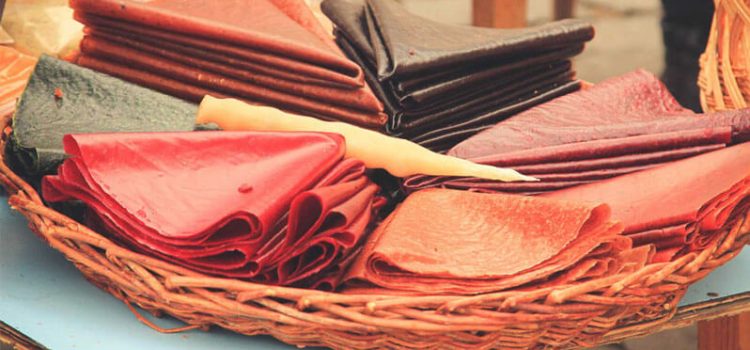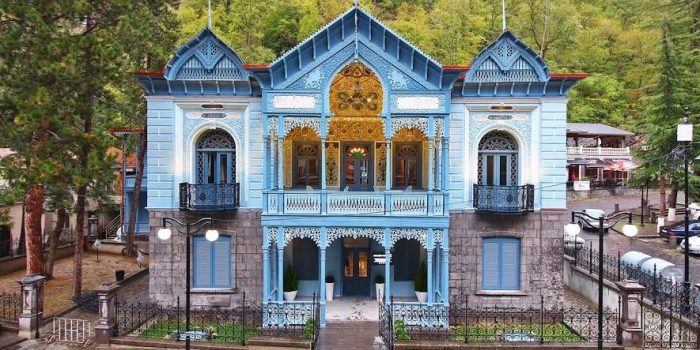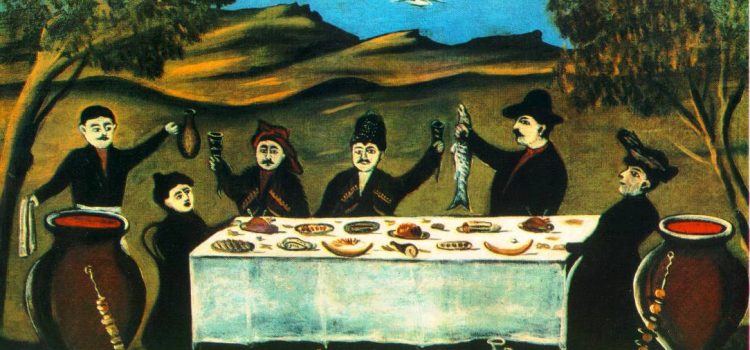Georgian desserts to taste in winter
Georgia offers a whole range of local dishes. Georgian cuisine has been shaped by different cultures such as ancient Greek and Roman, middle eastern Turkish, central Asian, Mongolian, Russian and Indian influences.
If you plan to spend winter in Georgia, you are recommended to taste top Georgian desserts. You will not be able to find the same taste elsewhere in the world.
Pelamushi is a Georgian dessert made with pressed and condensed grape juice, sugar, and flour. The liquid is gradually
heated until it thickens, and it is then poured into serving dishes, bowls, or various molds, in order to create attractive shapes. When fully chilled, pelamushi is ready to be served, and it is recommended to garnish it with various nuts and seeds.
Churchkhela is a traditional Georgian candy that is shaped into a sausage. It originated from the Caucasus region. This candy is made by dipping a long string of nuts (usually walnut halves) in concentrated grape juice, then leaving the concoction to dry. It is quite healthy and so nutritious that it was even carried by Georgian warriors on their long journeys in the past. Although walnuts are mostly used in the preparation of churchkhela, they can be replaced by almonds, hazelnuts, or raisins.
Tklapi is a unique Georgian dessert consisting of cooked fruit puree that is poured on a tray in a very thin layer and left to dry in the sun for a few days. It is typically prepared with fruits such as wild plums, pears, mulberry, figs, or apples. Visually, this healthy treat looks like a piece of leather. Tklapi can be consumed on its own or used in soups and stews.
Gozinaki is a traditional Georgian dessert with a crunchy texture, made with honey-fried, caramelized nuts such as walnuts, almonds, and hazelnuts. This sweet treat is often cut into diamond shapes, and it is traditionally consumed at Christmas and New Year.
Source: Georgianjournal.ge
The Guardian: Khinkali best eaten with alcohol
The Guardian published an article about the traditional Georgian dish Khinkali in 2017. The article reads about its history, art of consuming the dish and its types as well.
Georgians were ruled by Greeks, Romans, Iranians, Arabs, Byzantians, Mongolians, Ottomans, and Russians over the years. All of them brought their cuisine and ingredients into Georgia. Georgia managed to incorporate all the new ingredients and meals to create an identity for Georgian cuisine. When you eat Georgian food, you do not think it is Mongolian or Chinese but Georgian. Khinkali is believed to be brought by Mongolian warriors in the 13th century.
The dish is similar to the Taiwanese soup dumpling, xiaolongbao. The Georgian dumplings are filled with meat and spices (mushrooms, potatoes, cheese can be used instead of meat), then traditionally twisted into a knot at the top. Regional differences influence the fillings and every part of Georgia has their distinctive variety. For example, in the mountainous regions, the most traditional filling is lamb. The most frequent variety (often served in Georgian restaurants) throughout entire Georgia is a mixture of pork and beef.
Khinkali are traditionally the food of shepherds in the Tusheti and Pshavi regions mountainous regions of northern Georgia.
“Locals are skilled in the art of extracting the hot juices in one bite, cautiously using the top knot of dough as a handy grip. Plates strewn with discarded knots sit on cafe tables.”
The founder of Kartveli Tours (tours in Georgia) Irakli Shengelia says to the Guardian that both beer and vodka goes well with the dish. He explains the Georgian term Chakiduli meaning “a shot of vodka followed by a beer”.
Source: Georgianjournal.ge
CNN about abandoned Tskaltubo Spa
CNN has recently published an article about the abandoned sanatoriums of Tskaltubo, a town in the west part of Georgia. The article states that throughout the Soviet era, the USSR built 186 sanatoriums across the state. Tskaltubo spa is considered to be one of the best sanatoriums.
The natural springs emanate from limestone massifs deep beneath the ground, releasing radon-carbonated and mineral-enriched water. According to the European Historic Thermal Towns Association, the spa was regarded as “waters of immortality” dating back to 7th century. The springs are believed to have healing properties.
After the fall of the Soviet Union, the sanatorium lost its function, vines, bushes, and weeds found their ways through the pillared hallways into the bathing rooms. Later in 1992, a bloody conflict broke out between government forces and separatists who fought for the independence of Abkhazia, a disputed autonomous republic in northwestern Georgia. After the fall of Sukhumi, the capital city of Abkhazia, thousands of Georgians were forced to flee the city. The refugees found the deserted corridors of the Tskaltubo sanatorium as a shelter.
The refugees have never left the place. The original settlers have had children, and now grandchildren. They had to adapt and create makeshift homes.
The design of the sanatoriums was a model of progressive Soviet architecture. The architecture was a fusion of what is now known as classical Stalinist design and ethnic Georgian decor, as well as Gothic and Roman features.
“They were frozen in time and objects were just sitting there, as if someone had just got up and left. It was as if the buildings were still used by the Soviet citizenship. But the objects had now become artifacts.” – said the photographer Ryan Koopmans. The article is accompanied by his photographs taken in Tskaltubo.
Leaving behind the bad times, the government has begun to re-home refugees and developers plan to relaunch the spa as a luxury tourist destination. Thus, these photographs of Tskaltubo sanatorium might soon be the last memory of the era.
Source: Georgianjournal.ge, Photo: Georgianjournal.ge
Caucasus Wine University to be opened in Gurjaani
In the Kakheti region a new viticulture campus of the Caucasus University is in the process of planning. Although, no details about the opening date have been communicated so far, the Wine University is supposed to offer vocational, bachelor and master programs to students.
Davit Songhulashvili, member of Parliament and Gurjaani Majoritarian said: “The decision on the launch of the wine school in Kakheti region was made by the Caucasus University based on the
study, conducted by the university. I had the same initiative earlier. Our plans coincide with each other and the process was speeded up. Today, the Free University is the only university in Georgia, which involves the agrarian direction and it is located in Tbilisi. Kakheti is the region of viticulture and winemaking and consequently, such a university is very important here. ”
Indeed Gurjaani has a long tradition of wine and viticulture. The small town is located in the fertile Alazani River Plain and is surrounded by vineyards. From Tbilisi, it takes two hours by car, to reach the city in Kakheti.
There has recently been an increased push by the Georgian government to professionalize the national wine industry, particularly to strengthen export possibilities to the European Union and beyond. Although the Georgian wine history is 8,000 years old and 500 out of total 2000 known varieties in the world is Georgian, this direction is not sufficiently cared in terms of professional development, states also the wine industry.
Source: Georgianjournal.ge
History of the Georgian resort town Borjomi
Borjomi is a resort town located in the region of Samtskhe-Javakheti, Georgia. It is one of the most popular resorts in the country, famous for its mineral waters, unique nature and abundance of historical monuments.
Borjomi is believed to be founded in 1842. The initiative belonged to a doctor known as Amirov. Doctor Amirov’s idea was implemented by the Commander-in-Chief in the Caucasus Yevgeny Golovin and continued by his successors Mikhail Vorontsov and Mikhail Romanov.
Newly established town Borjomi became a famous spot due to its mineral springs, diverse nature, and mineral spas. It was a favorite resort town for the 19-20th-century nobility in Georgian and abroad. At first, the town was a serene place used for healing and health purposes. There were certain restrictions imposed on the people visiting mineral spas in Borjomi. They were not allowed to smoke or gamble.
In the 1850s, Borjomi used to offer only several mineral baths, cottages for soldiers, villas, and outdoor markets. Later, the constructions of hotels, roads, and bridges began to launch. Considering the growing popularity of the resort town, the Emperor of Russia Alexander II allocated finances for the construction of the Romanov Palace in 1970.
The history of the brand Borjomi (naturally carbonated mineral water from springs in the Borjomi Gorge of central Georgia) is also associated with the Russian imperial dynasty of Romanov.
As the venue has been visited by millions of guests from every part of the world, the architecture of the building in Borjomi is versatile. It consists of the styles of Asian, Russian, pseudo-gothic and European architecture.
Source: Georgianjournal.ge, Photo: Georgianjournal.ge
Top 10 Must-Try Georgian Dishes
Georgians were ruled by Greeks, Romans, Iranians, Arabs, Byzantians, Mongolians, Ottomans, and Russians over the years. All of them brought their cuisine and ingredients into Georgia. Georgia managed to incorporate all the new ingredients and meals to create an identity for Georgian cuisine. When you eat Georgian food, you do not think it is Mongolian or Chinese but Georgian.
Here are the top 10 dishes to taste in Georgia:
1. Khachapuri
khachapuri is the most famous dish in Georgia. The pastry is traditionally topped with melted cheese, eggs and butter. There are different types of khachapuri but it is usually filled with Georgian Sulguni or Imeretian cheese. Three of the most common varieties include the Imeretian khachapuri, shaped into a circular form, Adjarian khachapuri, the open-faced version topped with butter and a raw egg on top and Megrelian Khachapuri shaped into a circular form and topped with melted cheese.
2. Kuchmachi
Kuchmachi is a traditional Georgian dish made of pork/chicken hearts, livers, gizzards mixed with walnuts and pomegranate.
3. Shkmeruli
Shkmeruli (roast chicken in garlic sauce) is a very old Rachan dish and it is one of the most popular dishes in Georgian restaurants. It has to be noted that the name derives from one of the villages in Racha region of Georgia, Shkmeri, which is said to be the place where this food has originated.
4.Khinkali
Georgian dumplings known as khinkali are considered to be one of the national dishes of the country. The dumplings are filled with meat and spices (mushrooms, potatoes, cheese can be used instead of meat), then traditionally twisted into a knot at the top. Regional differences influence the fillings and every part of Georgia has their distinctive variety. For example, in the mountainous regions, the most traditional filling is lamb.
The most frequent variety (often served in Georgian restaurants) throughout entire Georgia is a mixture of pork and beef.
5.Ostri
Ostri is hot and spicy beef with tomato sauce. The meat should be very tender when fully cooked.
6. Kubdari
Kubdari is a bread filled with beef, pork, or a combination of the two flavored with spices such as cumin, dill, coriander, blue fenugreek, red pepper, onions, garlic, and salt. The dough consists of flour, water, yeast, sugar, salt, and eggs. Interestingly, the meat used in this savory pie should be cut, not minced. Kubdari originates from Svaneti, one of the most beautiful mountainous and winter resorts in Georgia.
7. Chikhirtma
Chikhirtma is a famous Georgian soap. It is often believed that the soap is the best hangover cure. It consists of chicken pieces, onions, eggs, flour, vinegar, water, and seasonings such as salt, bay leaves, and coriander. It has a slightly sour flavor and a thick, creamy consistency. The soup is usually served hot, and it is recommended to garnish it with freshly chopped coriander.
8. Satsivi
Satsivi is a thick nut paste. It usually includes garlic, coriander, cinnamon, vinegar, and hot peppers. Satsivi is typically served as an accompaniment to meat dishes. However, it can also be served with vegetable dishes, alongside fish, or even with boiled eggs.
9. Elarji
Elarji is a specialty of the Georgian Samegrelo region (western Georgia), prepared as a thick porridge consisting of coarse cornmeal, cornflour, and sulguni cheese. The dish has an extremely thick texture, and it is very elastic. It is traditionally served hot and consumed with Georgian bazhe sauce, made with garlic, walnuts, and various spices.
10. Pkhali
Pkhali is a traditional Georgian dish of chopped and minced vegetables, made of cabbage, eggplant, spinach, beans, beets and combined with ground walnuts, vinegar, onions, garlic, and herbs.
Source: Georgianjournal.ge
Photo: Georgianjournal.ge
7.5 km long cable car opens connecting Kobi, Gudauri ski resorts
A 7.5 km long cable car between the ski resorts of Kobi and Gudauri opened earlier today, connecting the Stepantsminda region to Gudauri in just 15 minutes.
The cable car will serve to make both Kobi and Gudauri more functional winter resorts, offering easier transportation in the area.“Georgia will take its place on the global map as a country with the most successful ski resort. Number of tourists has increased by 500 percent in Gudari during last six years. This is a great success but not enough. This cable car is truly unic which will unify Gudauri and Kobi in one cluster. Outstanding Swiss and Austrian resorts have managed to achieve best results through realisation of the same strategy and I am sure that we are also getting closer to this level,” PM Bakhtadze said at the opening ceremony.
Kobi is a village in Stepantsminda, while Gudauri is a ski resort located on the south-facing plateau of the Greater Caucasus Mountain Range.
The distance between Kobi and Gudauri is 15.2km and by car you can cover this distance in about 22 minutes – but since landslides and heavy snow can force the car route through Jvari pass to shut in the winter, the new cable car will help the commuters or skiers transport back and forth anyway.
About 81 million GEL was allocated from the state budget to construct the Kobi-Gudauri cable car with the capacity of carrying 2,800 people in an hour.
Source: Agenda.ge
Forbes Features “Unique” Georgian Wines
Forbes published an article this week by contributor Lana Bortolot titled ”Why Georgian wines are Among the Most Unique on the Planet”.
Bortolot is a wine, food, and travel reporter who holds the Advanced Wine & Spirits Education Trust certificate and has covered wine regions in more than 16 countries.
In the article, Bortolot explores Georgian wine culture, the role of wine in modern Georgian society, and the technical side of Georgian wine. The piece is peppered with quotes from Georgian wine lovers:
“Even where we think a culture like France or Italy is so wine-centric, Georgians just take it to a whole different level—much deeper than what we’re exposed,” – Taylor Parsons
“There’s something very particular about how Georgians love wine,” he said. “It’s a little eccentric but then you start looking into it and once you do, you’re truly amazed—it’s such an integral part of the culture and everyday life.” – Noel Brockett
“One of the most important things about Georgian wines is that it’s a window into a culture that most of us as Westerners simply don’t have,” – Simon J. Woolf
Bortolot goes on to focus on orange or amber wines, a style growing in popularity worldwide that has long been part of Georgia’s tradition. She also recounts a legend, which said that, in ancient times, “soldiers wove a piece of grapevine into the chain mail protecting their chests, so when they died in battle, a vine sprouted not just from their bodies, but their hearts.”
The article introduces readers to several Georgian wine makers – locals and expats, high end factories and garage operations – celebrating the varied, inclusive culture of Georgian wine.
The article ends with a wine sampler. Bortolot recommends Kisi, Mtsvane, Rkatsiteli, Saperavi, and Tsinandali for beginners.
By Samantha Guthrie, Source: Georgiatoday.ge
Arles Museum to Host the Exhibition of Niko Pirosmani Paintings
After famous Albertina Museum in Vienna, ‘Niko Pirosmani – A Wanderer between Worlds’ will continue its journey through other European countries.
The next ‘stop’ for the exhibition will be Arles Museum of Modern Art in the South of France. The works of the self-taught primitivist painter, who represents a unique figure of Georgian art will be displayed alongside the paintings of the prominent Dutch impressionist Vincent van Gogh, who lived in Arles for a time.
The exhibition is scheduled for March 2019 and will likely last until summer. It was stated by the Georgian National Museum that negotiations are ongoing about the details of the organization of the exposition. The exhibition is prepared by the Georgian National Museum (GNM) network and the Vincent van Gogh Foundation in Arles.
29 works of Pirsomani, currently being displayed at the Albertina Museum, will be showcased in Arles.
The opportunity to exhibit Pirosmani’s paintings at Albertina is considered an unprecedented success in promoting the country and its culture. General Director of the Georgian National Museum David Lordkipanidze told Imedi TV, the given exhibition had record-breaking viewer numbers.
After Austria, the French audience will also be presented a chance to observe the paintings of Pirosmani and explore the Georgian avant-garde.
By Ketevan Kvaratskheliya, Source: Georgiatoday.ge
Image source: imedinews.ge
Georgian Food Named as Cuisine of the Year by Af&co
Af&Co has named Georgian food as Cuisine of the Year and Khachapuri as its dish of the year in its 2019 Trends Report.
Based in San Francisco, af&co is a leading restaurant and hospitality consulting firm. Their report identifies the hottest key trends in restaurants, food and beverage, and hospitality marketing.
The Ajarian dish Khachapuri has been awarded the title of Dish of the Year thanks to its tasty combination of cheese and egg, and its instagramability. It’s already being served in some restaurants in the US, including Supra in Washington DC, Cheeseboat in Brooklyn and Barbounia in New York.
The Trends Report was the eleventh edition published by af&co. Founder Andrew Freeman noted that “the hospitality industry is leading the charge in creating the world we want to live in. Restaurants and hotels are gathering places for people to connect, creating the perfect grounds for people to come together, get personal, and embrace forward-thinking ideas.”
By Amy Jones, Source: Georgiatoday.ge
Photo source: reddit.com











